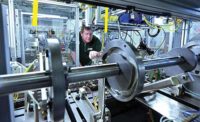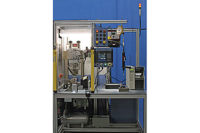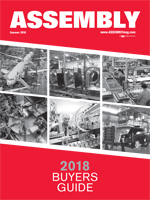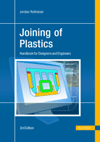From trigger sprayers to disposable shavers, high-speed automation systems assemble consumer products by the millions.

Precision Valve Corp. is one of the largest manufacturers of disposable plastic valves in the world. Its assemblies top bottles of glass cleaner, pesticide, fragrance, shaving cream, styling mousse and myriad other products. In 2004, the company assembled some 4 billion trigger sprayers, finger pumps, spouts and other products. That’s more than 13 valves for every person in the United States!
Even the fastest automated assembly system can’t keep up with that kind of volume, not by itself, anyway. At a production rate of 1,000 parts per minute, an automation system operating nonstop, 24 hours per day, 7 days per week, can produce 524 million assemblies, or just over 13 percent of 4 billion.
But that’s not all. Precision Valve is one of at least five U.S. manufacturers of disposable plastic valves, and several more are located in Europe and China. When you throw in the innumerable other small plastic assemblies produced by the millions each year-pens, shavers, lighters, cosmetics containers, air fresheners-you begin to get an idea of the importance of high-speed automation to the consumer products industry.
Consumer products are assembled on both synchronous and asynchronous automation systems, depending on the number and shape of the parts, the processes for assembling them, and the production volume and variety.
A relatively simple assembly, such as a valve with a few round parts, is an ideal candidate for a continuous motion system, says Scott Corbin, product manager at systems integrator Haumiller. These machines can easily produce 150 to 900 assemblies per minute, and some can output more than 1,200 assemblies per minute. On a continuous motion system, the transfer mechanism doesn’t start and stop, as with an indexing system. Rather, assembly operations are carried out as the parts are moving, and the tools travel with the work in process.
The heart of a continuous motion assembly system is a rotating cylindrical turret. The turret consists of a round dial with a series of tools, called pins, arrayed around its circumference. Parts enter the system single file on tracks from feeders or upstream operations. A star wheel, moving synchronously with the turret, strips off parts one after another and transfers them into nests around the dial. As the turret rotates, each pin is actuated in turn until the process is complete and the assembly is unloaded.
“If most of the components are circular and symmetrical, and if they can be assembled without any radial orientation from one part to the next, then they will be easy to feed into a continuous motion system,” says Bob Ensminger, CEO of systems integrator Arthur G. Russell Co. Inc. “They can easily be snapped or pressed together. This can be done at high speeds and in a relatively small footprint.”
Fives Group recently built a continuous motion system for assembling pen caps. The dial has 80 fixtures and assembles caps a rate of 300 per hour. Caps are fed from a vibratory bowl and placed into the fixtures horizontally. Metal clips are fed from a vibratory bowl to a wheel mechanism. As the wheel rotates, it places a clip, tangs down, onto a cap. Then, a cam-actuated crimping tool pushes the clip against the cap with enough force for the tangs to penetrate the plastic. A spring-loaded mandrel is then inserted into the cap to fold down the tangs against the inside wall of the cap, securing the clip. The crimping tool is then cammed down and the finished cap is inspected. Good assemblies are unloaded, while bad assemblies are rejected.
More complex assemblies require a rotary indexing dial or an indexing carousel. A rotary dial can have up to 16 stations mounted around a turntable driven by a central, vertical shaft. The primary actions of the stations are produced by cams connected to the main drive by horizontal shafts and bevel gears. Secondary movements are carried out by pneumatic mechanisms that are also controlled by the main drive. Depending on the application, rotary indexing dials can achieve assembly rates of up to 200 indexes per minute.
If space is an issue, or if more than 16 stations are needed to assemble the product, a carousel might be a better choice. In a carousel system, fixtures are mounted to a continuous steel belt strung between two wheels. A central camshaft drives the two wheels, as well as the assembly stations, which can be installed both inside and outside the belt loop.
“If there are a lot of parts and you need multiple feeders, a carousel chassis works nicely, because you have lots of space,” observes Ensminger. “An indexing dial can get very congested with too many parts feeders around it. A carousel system can index at up to 60 cycles per minute, and you can typically double- or triple-tool the machine to increase the production rate.”
An asynchronous system is another possibility, particularly if some assembly processes take longer than others. An asynchronous system is also advantageous if the manufacturer requires some flexibility. For example, Isthmus Engineering & Manufacturing recently designed a power-and-free system to assemble and test two types of aerosol pumps. Each assembly consists of four parts, which are fed into the system from vibratory bowls. The assemblies, four to a pallet, travel from station to station on a plastic-chain conveyor. The assemblies are inspected after each part is added, and linear and rotary force tests are performed on the assemblies before they are unloaded. The system produces 30 assemblies per minute.
In some cases, different types of systems are combined. For example, a continuous motion system might feed subassemblies into a rotary indexing dial. Or, an asynchronous system might be used to accommodate processes, such as testing or packaging, that are too slow or too bulky to integrate into a continuous motion system.
For example, Haumiller recently designed a system that combines both continuous motion and rotary indexing machines. The system assembles and tests finger pumps for a small plastic bottle. Most of the pump is assembled on the continuous motion system. Supply tubes are inserted into the pumps on the dial, since those parts are larger and more flexible than the pump’s other parts. The system assembles pumps so quickly that a high-speed video camera is needed to analyze its performance.
“When you’re running 1,000 parts per minute, it’s hard to see what’s going on when there’s a fault,” explains Corbin, whose company has designed machines to assemble some 813 different nozzle and valve designs.

Assembly, Test and Inspection
High speed and low cost are the chief concerns when assembling small plastic parts for consumer products. As a result, parts are typically designed to be snapped, pressed or crimped together. Ultrasonic welding, spin welding, heat staking, inductive welding and laser etching are less common processes, while threaded fasteners, rivets, tapes and adhesives are rarely used unless they are functionally necessary. “If you have to bond the parts, you’re adding another material, another process step, and that just adds to the cost of the product,” says Ensminger.
As for test and inspection, manufacturers of low-cost, high-volume consumer products are no different than manufacturers of auto parts or medical devices. Every assembly must function perfectly, even if it only costs a few pennies. No consumer wants a jug of laundry detergent with a leaky valve or a ball-point pen that sticks open. Thus, an assembly system is typically configured as a series of alternating operations: add a part, inspect it, add a part, inspect it. This routine is important not only for assembling quality products, but also for maintaining up-time of the machine.
“It’s unusual to place a part on an assembly without checking to ensure that it’s there and in the correct position,” says Corbin.
Machine builders have several options for inspecting parts. Tooling on bowl feeders can weed out nonconforming parts before they reach the assembly. The height of an assembly can be checked with a photoelectric sensor or a proximity sensor in conjunction with a probe or wiper. An assembly that is too short would indicate that a part was not added successfully. Vision systems can be programmed to check a number of attributes, including color, shape and dimensions. These systems quickly identify missing features or misaligned parts.
Testing is less common than inspection, due to the simple nature of the products. Leak or flow testing is often performed on valves. Force testing is sometimes done on spring-actuated assemblies, while torque testing is occasionally done on assemblies with rotating parts.
Although quality checks are important, engineers must balance cost vs. benefits whenever they add test and inspection steps. “Sometimes you can skip an inspection step, but it’s a risk,” says Corbin. “You could take all the risk out of the assembly process, but it might get ludicrously expensive.”
Design Issues
Automatic assembly systems for consumer products can often be built faster than systems for other products, especially if the integrator has previously built systems for similar products. The lead time depends on the complexity of the product. For example, a system to assemble a product with five components can usually be designed and built in 8 to 12 months.
Of course, designing the product itself can take a year or more, and engineers are well-advised to contact systems integrators early in the design cycle. Often, integrators can suggest slight changes to the parts that will facilitate feeding and handling with automatic equipment-without affecting the functionality or appearance of the final product.
“One of the worst [technological] developments was solid-modeling tools,” laments Ensminger, a bit facetiously. “Now, engineers can design products with no planar surfaces. Everything has curves, radiuses and strange angles. The parts look very nice and they feel very nice, but they are more difficult to handle in an automated assembly system.”
Indeed, Ensminger recalls the challenges posed by a system his company built recently for assembling disposable razors. “We wanted to feed the handles side by side,” he says, “but they had a lot of curves and were very difficult to get hold of reliably.”
To solve the problem, Ensminger persuaded the customer to add two small bumps on the handle. “They almost look like they belong there, like they are functional,” he explains. “But, they are really there to help us feed and fixture the part. They don’t look out of place, and they made a big improvement in how the part would feed. Often, the solution to a feeding problem is something very simple like that.”
Springs, a common feature of many consumer products, are also tricky to handle, because they tangle in feeders, says Corbin. He recommends closed-end springs over open-end springs. On a closed-end spring, each end of the wire coils back on itself. On an open-end spring, the ends of the wire protrude into space. A closed-end spring sits upright when stood on end; an open-end spring does not.
If parts of the product have yet to be finalized, integrators may be able to “leave room” in the system to accommodate changes. “Usually, the product goes through some minor modifications as the system is being designed,” says Ensminger. “But, if the customer can tell us which parts of the product are still subject to change, we can anticipate that and make allowances in the tooling and fixturing, so we don’t have to go back to square one.”
Once the product has been finalized, however, integrators will need a good supply of production parts to test the machine. Tens of thousands of parts are usually necessary, says Corbin.
Sometimes, problems with automated assembly of consumer products aren’t related to the shape of the parts, but to how well they are made. In this regard, consumer product designers often face a catch-22. Manufacturing tolerances must be set tight enough so that parts can be fed and handled easily in high-speed automation. At same time, however, tolerances cannot be set so tightly that the cost of the parts increases.






